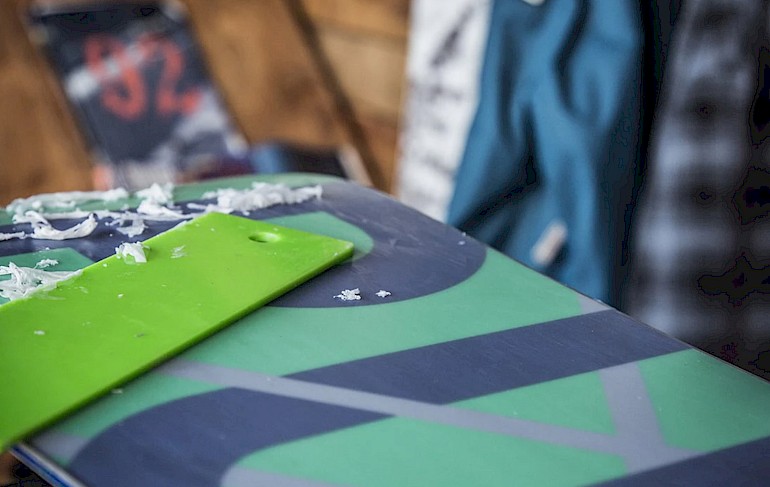
Snowboard Maintenance, Waxing and Tuning
The Essential Guide to Snowboard Maintenance and Tuning
Regular maintenance and snowboard tuning can significantly enhance your riding, prolong the life of your snowboard, and ensure optimal performance on the slopes. Snowboard manufacturers use a variety of base grinding and final base treatment methods. However, both new and used boards should undergo regular maintenance to enhance performance and life. Here’s a guide to help you keep your board in top shape.
Why Do We Tune Our Snowboard?
Regular maintenance prevents damage and ensures your board performs at its best. A well-tuned snowboard can improve edge grip, glide, and overall responsiveness. Neglecting your gear can lead to poor performance, increased wear and tear, and potentially costly repairs. To maintain performance of your board it should be tuned regularly.
Basic Tool List
* Base Cleaner
* Edging Tool
* Rasping File
*10mm file
* Deburring stone
* Waxing Iron
* Rags
* Wax
*Scrapper
* Scourer
* Nylon Brush
Snowboard Maintenance
1. Cleaning Your Snowboard
After Each Ride: Use a damp cloth to wipe down the base and edges to remove dirt, snow, and salt. This prevents rust and grime buildup.
Deep Cleaning: At the end of the season, use a soft brush and a mild detergent to clean the base thoroughly. Rinse well and let it dry.
2. Edge Maintenance
Check for Burrs and Dents: Inspect edges regularly for damage and Sharpness as edges are crucial for grip on icy slopes. To check if your board requires edging, run your finger down the length of the board. If your finger catches on the edge you have burrs – small areas of the edge which need to be removed with a deburring stone prior to sharpening. If there are no burrs you can then test the edge for sharpness by running your finger across the edge from base to top along the board. With a little practice you will soon be able to identify a sharp edge
Sharpening: Use a diamond stone or file to sharpen the edges. Aim for a 90-degree angle for maximum grip, or adjust to a slight bevel for easier turns.
Base Edge Filing
Place the file diagonally ¾ distance across the board. Apply pressure directly above the edge and base with both hands. Use long, even strokes from one end to the other. Avoid stopping and starting in the same place each time. Continue until a smooth edge is obtained and repeat on the other edge.
Side Edge Filing
To finally bring out that sharp edge and to maintain a 90 degree angle use a short file attached to a holding device. Apply even pressure with your thumbs while using long even strokes from tip to tail. Avoid stopping and starting in the same place each time. Continue until a smooth edge is obtained. And repeat on the other side.
Deburring and Detuning
After the edges are sharp and the base is correct, the rough edge, or burr, left by the filing should be removed with a honing stone. Also on most boards, the last few centimeters of the contact edge should be dulled back, since a sharp tip and tail can be very catchy
3. Wax Your Snowboard
Frequency: Wax your board every 3-5 days of riding or whenever the base looks dry. Regular waxing enhances glide and prevents base drying.
How to Wax:
To prevent the base from drying out (making it slower and more susceptible to damage) your board should be waxed. A universal wax may be used or temperature specific if greater performance is required. The following sequence should be followed to obtain optimal results.
1. Melt the wax on the base using an electric iron or a waxing iron.
2. Iron the wax over the base keeping it in a liquid state for 20 – 60 seconds per square foot to maximize
the wax absorption through the pores
3. Avoid temperatures exceeding 140C as it could damage the base. If the wax begins to smoke it is too
hot.
4. Allow wax to cool slowly to room temperature, then scrape of the excess with a plastic scraper.
5. Finish process by brushing with a plastic brush to smoothen and structure the wax.
4. Base Repairs
Check the Base
Small scratches usually do little more than aesthetic damage; large deep scratches and gouges however can do serious damage to a board if left without being repaired. Besides affecting the board’s performance, humidity may seep in and cause the board to delaminate.Small scratches can usually be fixed with a simple wax, but deeper gouges may require p-tex repair.
P-Tex Repair
Bases can be repaired with P-tex in the following way: Dry out the area to be repaired thoroughly and clean the area to be repaired. Remove any jagged edges with a sharp knife or razor blade and Sand lightly with silicon carbide sand paper. Fill the hole or gouge with P-tex. Light the P-Tex candle on fire and allowing it to drip in the hole. Let dry, scrape and sand smooth.
5. Binding Maintenance
Check Screws and Straps: Regularly check that all screws are tight and straps are in good condition.
Cleaning: Remove dirt from the bindings using a damp cloth and ensure that they are functioning smoothly.
6. Storage Tips
End of Season: Clean and wax your board without scraping before storing. This prevents the base from drying out.
Store in a Cool, Dry Place: Avoid leaving your board in extreme temperatures, such as in a car or direct sunlight.
Taking the time to maintain and tune your snowboard will enhance your performance on the slopes and extend the lifespan of your gear. By following these simple maintenance practices—cleaning, repairing, sharpening, waxing, and proper storage—you can ensure a smooth and enjoyable ride for seasons to come. Happy shredding!



